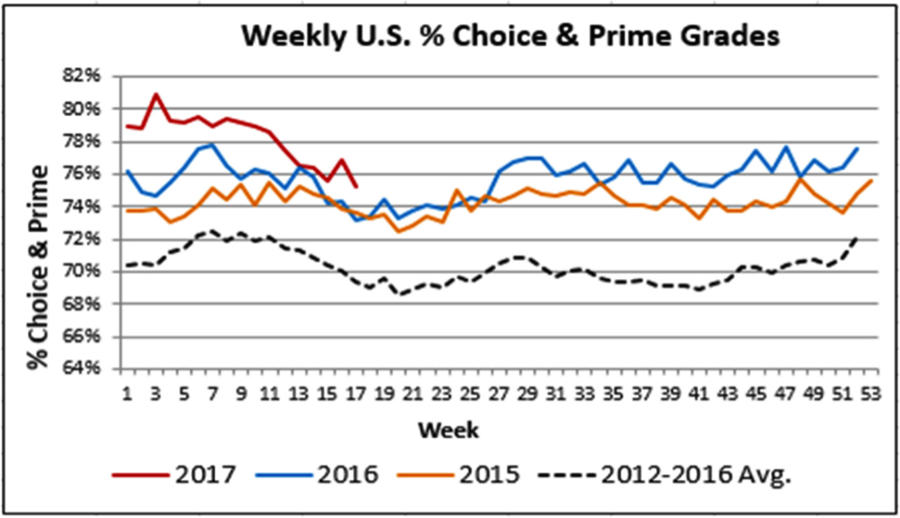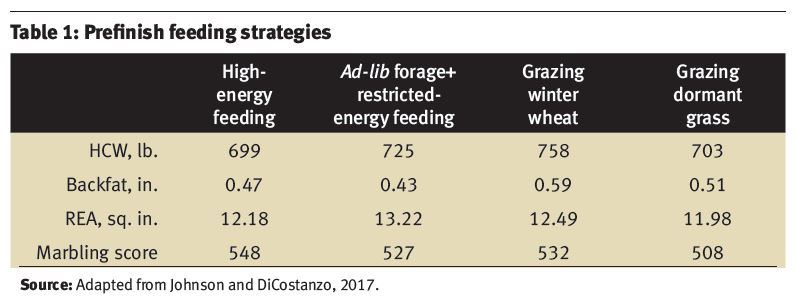
Don’t blame the calves
“20 Questions,” my neighbors used to call me. Laughing at my genuine curiosity to common opinion, they’d say, “Laura, that’s just the way it is!”
In many instances, things are just what we all say they are, and I think that’s a good thing. It can be a relief to learn from those who came before you, trusting the tried and true ways of thinking and doing.
But sometimes, common opinion, well it’s just that – an opinion.
And when it comes to this gig, I’d say it pays to ask “why.”
Exhibit A: 
Percent marbling in harvested fed cattle tends to decrease from late February to early May. At the same time feedlots tend to get more calf-feds (calves fed a high-energy diet at an earlier age and weight) rather than yearlings.
That’s a reality.
“Blame it on the calf feds,” you’ll hear.
That’s an opinion.
“It’s interesting that perception is out there, given there’s knowledge that calf-feds actually marble better,” says Minnesota animal scientist Alfredo DiCostanzo.
Along with a graduate student, he conducted a meta-analysis that suggests the long-held belief just isn’t true. Not to mention today’s economic conditions, beef genetics and value-based markets certainly favor a calf-fed approach.
So why the contradiction?
It’s a complex system, our own Justin Sexten would say. Past data doesn’t fully represent today’s cow herd as genetics have moved them farther and farther away from what was.
As for the quality grade hit, there’s a long list of reasons we could attribute to why. Young calves are more prone to sickness in the early stages of feeding and the first calf-feds harvested are often lighter. Weather and where they came from come into play, as well as a spread in genetic potential.
But that’s a lot of information. 
Here’s what we know:
- Cattle sell on pounds, yet there are and will be added rewards for marbling.
- Yearlings today can gain 2 lb. on a moderate level of energy while growing. Calf-feds now reach finished weights once unimaginable.
- If the spread is favorable, adding a little more energy to calves’ backgrounding diets or reducing the backgrounding period so that cattle stay lighter could avoid discounts and put money in ranchers’ pockets.
You may even be in a position to have the best of both worlds.
“If you’re able to background to about 800 pounds, no more than that, and at that point turn them onto a high-finishing diet, harvesting at 1,400 lb.–that should be able to give you both weight and marbling,” Alfredo says.
The reality is there is no right or wrong answer, but rest assured we’ll be here to keep asking “why?”
Thanks for allowing me to tell your story,
Laura
You may also like
Nebraska Ranch Receives Certified Angus Beef Commercial Award
Troy Anderson, managing a Nebraska ranch, focuses on breeding thriving maternal cows that will grade premium Choice and Prime, while respecting livestock, people and land. Anderson Cattle receives the 2023 CAB Commitment to Excellence Award. Their journey includes improving genetics, feeding home-raised and purchased calves and using data for better breeding decisions, all with a bottom-line approach.
Magnum Feedyard Earns Certified Angus Beef Award
While Magnum hasn’t always had pens filled with Angus-influenced cattle, they’ve invested in infrastructure, improved quality-based marketing and sought better genetics. Their dedication to detail and employee appreciation drive their success to high-quality beef production.
Everything They Have
Progress is a necessity on the Guide Rock, Nebraska, ranch where Troy Anderson manages a commercial Angus herd, small grower yard, his 10-year-old son, and a testing environment. Troy’s approach includes respect for his livestock, people and land. For that, Anderson Cattle was honored with the CAB 2023 Commercial Commitment to Excellence Award.



